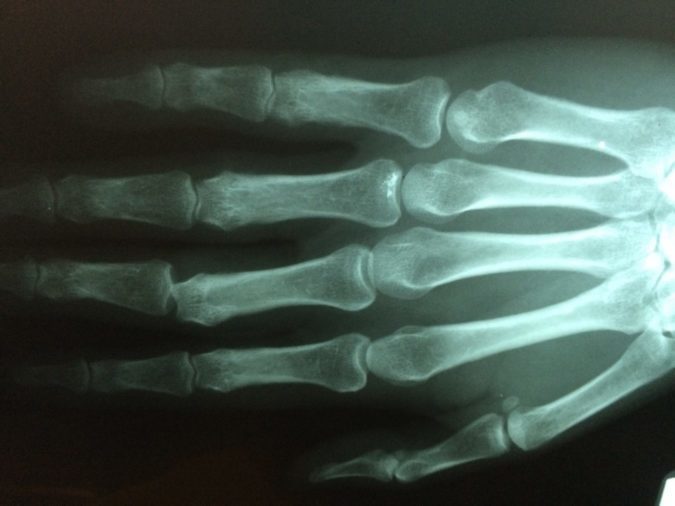
Have you ever wondered what are the most common broken bones in the human body? Well, perhaps surprisingly, the most common bone to break is actually the clavicle, more often known as the collarbone.
The clavicle is the bone that runs across the front of the body from shoulder to shoulder. Due to its length and slenderness, as well as its prominent position, it breaks quite easily. Most people will put their arms out in front of them when falling, but this is one of the most common ways to break your clavicle. Contact sports are also a major cause of clavicle fractures, but they can also happen from something as simple as tripping on a pavement.
Luckily, a broken collarbone only takes about 6-8 weeks to heal in most adults. However, surgery may be needed if it’s a severe injury such as a bone breaking through the skin.
The Top 10 Broken Bones
1. Clavicle
2. Arm
3. Wrist
4. Hip
5. Ankle
6. Foot
7. Toe
8. Hand
9. Finger
10. Leg.
The bones of the arm are also some of the most commonly broken, particularly the humerus. The humerus is the large bone between the shoulder and elbow and a break often occurs as a result of a fall or a collision. It is the most common broken bone in children. The ulna, in the lower arm, is also a common bone to break.
There are many different types of breaks, including compound fractures, where the same bone breaks in a number of places, and a displaced fracture where the arm will look out of place and deformed. A closed fracture is where the skin hasn’t been broken and the arm looks more normal. A closed fracture is usually less serious and heals more easily.
The next most common break involves the wrist. The correct name for a wrist fracture is actually a ‘distal radius’ fracture or a ‘Colles’ fracture (after the 19th century surgeon who first described it). This is a common fracture in young people, as it is often sustained during activities such as skiing or skateboarding.
Staying in the wrist, sometimes a fracture can occur in the scaphoid bone without the sufferer realising, as there is usually very little swelling or deformity. A scaphoid fracture rarely heals without surgery however, so it is very important that a correct diagnosis is made.
Another bone that commonly breaks is the hip, particularly in people aged over 65. Although it is one of the strongest bones, the femur, which is the bone involved in a hip fracture, can be weakened by osteoporosis, which causes a loss of calcium that weakens its internal structure. Most hip fractures in older people result from falls.
Ankles are also prone to breakage. The ankle area is made up of three bones; the tibia, fibula and talus. It can be difficult to know if a break has occurred, as even the tendon damage of a sprained ankle can be very painful and prevent the sufferer from walking. As well as the more obvious breaks, ankles can sustain stress fractures which are when the bone cracks as a result of repeated pressure on it. This can occur if you run a lot.
After the ankle, the bones in the foot are the sixth most commonly broken. The foot actually contains 26 bones, some of which are extremely small, so it comes as no surprise that they can be easily broken, especially given the impact placed on them.
Everyone has experienced the pain of an injured toe, and a broken toe is surely even worse. Despite the pain, most toe fractures are not serious and don’t require any special treatment other than being kept immobilised.
Often a break to one of the 27 bones in the hand occurs as part of a more complex injury where there has also been damage to the tendons, nerves and blood vessels. There may also be breaks to multiple bones in the hand. The most usual causes of hand fractures are falls, sporting injuries, crushing, road accidents and fights.
Leg bones are usually some of the strongest in the body and it takes a big impact such as a serious fall or a car accident for them to break. A fracture that occurs lower down the femur is classed as a broken leg rather than hip and is one of the most painful breaks to experience.
How Do I Know If I’ve Broken a Bone?
Three common signs of a broken bone are pain, swelling and deformity. If not all of these signs are present, it can be difficult to tell, especially if the bone isn’t out of place. However, if the correct treatment isn’t received, a serious infection or permanent deformity can develop.
The record for the most broken bones in a lifetime is held by Evel Knieval, the famous motorcycle stuntman, who sustained 433 fractures by the end of 1975, when he retired from major performances.
If you believe you have broken a bone as a result of medical negligence, our team of solicitors can provide supportive advice and help you seek compensation. Get in touch today to learn more about broken bone compensation claims.


















